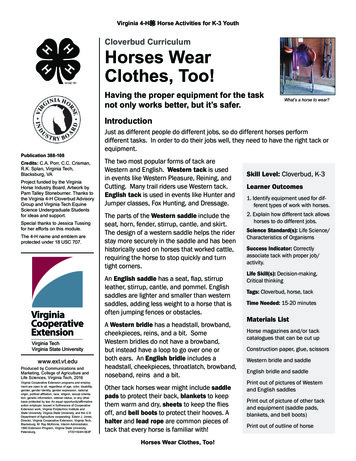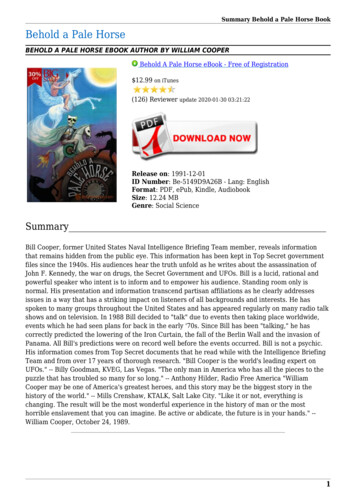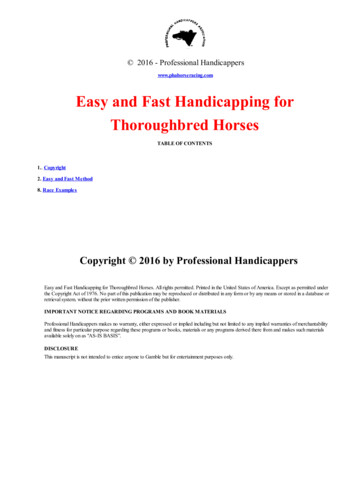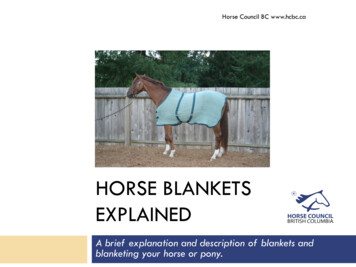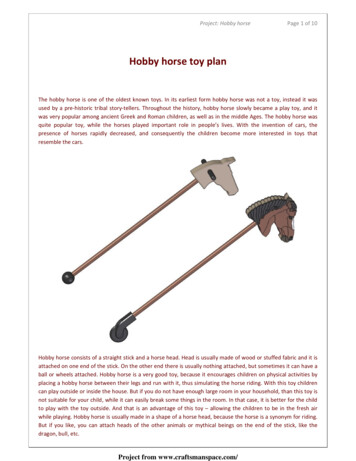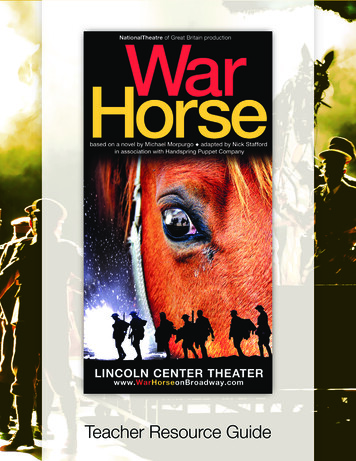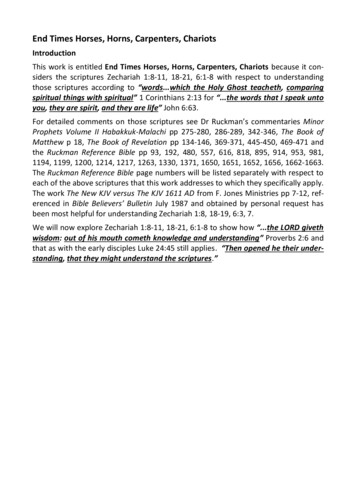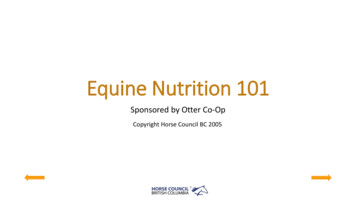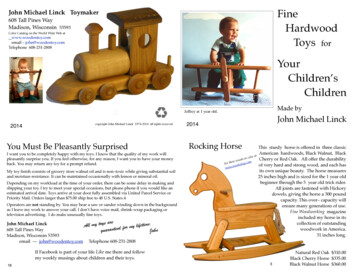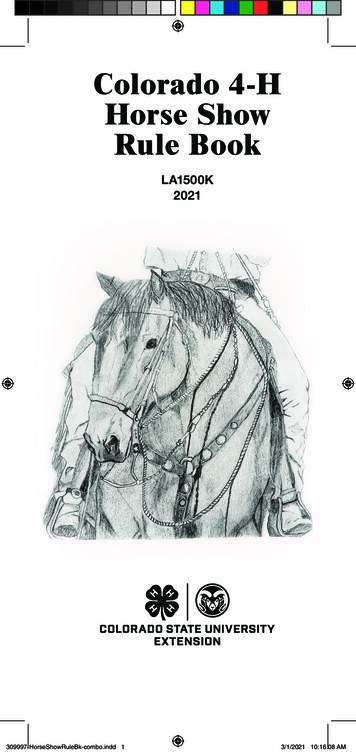
Transcription
Colorado 4-HHorse ShowRule BookLA1500K2021309997-HorseShowRuleBk-combo.indd 13/1/2021 10:16:08 AM
ACKNOWLEDGMENTSThe following members of the Colorado 4-H StateHorse Advisory Rules Subcommittee assisted in therevision of the current Colorado 4-H Horse ShowRulebook:Angela Mannick (Elbert)Jodie Martin-Witt (Larimer)Tiffany Mead (Jefferson)Carmen Porter (Boulder)Tom Sharpe (Mesa)Jonathan Vrabec (El Paso)Lindsay Wadhams (Colorado State Fair)PERMISSION TO REPRODUCE PUBLICATIONRequests for permission to reproduce any parts or all ofthis Colorado 4-H Youth-Development publication shouldbe directed to:4-H Publications LiaisonState 4-H OfficeColorado State UniversityCooperative Extension4040 Campus DeliveryFort Collins, CO 80523-4040Extension programs are available to all without discrimination. To simplify technical terminology, trade names ofproducts and equipment occasionally will be used. Noendorsement of products named is intended nor is criticismimplied of products not mentioned.Members are referred to the Colorado State Fair website forrules regarding entries for the state 4-H Horse Show held atthe Colorado State Fair.2020/2021309997-HorseShowRuleBk-combo.indd 23/1/2021 10:16:08 AM
TABLE OF CONTENTSAcknowledgments.inside front coverColorado State 4-H Horse Show Rules.2Use of the Name and Emblem of 4-H Club Work.2Horse Humane Policy Statement.2Protective Headgear Policy.2General Rules and Requirements.3Show Rules and Requirements.44-H Horse Drug and Medication Rule.6Breed Specific Rule.6Definitions and Descriptions.7General.7Gaits.7Bits, Curbs and Reins.9Showmanship Division.15Western and English. 15Questions. 19Patterns (Suggested). 19Western Division. 21Western Horsemanship.23Western Riding.28Reining. 42Western Dressage.65Trail Division.67Western and English. 67Scoring. 67Obstacle Set-up. 70Gymkhana Division. 74Individual Events.77Team/Group Events.86Working Western Division.87Heading and Heeling.87Breakaway Roping.90Steer or Calf Daubing.90Goat Tying/Goat Tail Tying. 91Team Penning. 91Ranch Horse Division.94Ranch Horsemanship.96Ranch Cattle Sorting. 110Ranch Trail. 114Individual Cow Work. 117Ranch Cutting. 121Ranch Riding.125English Division. 141Saddle Seat Equitation and Dressage Seat Equitation. 143Hunter Seat Equitation (Not to Jump). 146Hunter Seat Equitation Over Fences. 151Hunter Hack. 155English Show Hack Class. 157English Control. 158Dressage. 167Cover art courtesy of Marina Guynn from Elbert County.309997-HorseShowRuleBk-combo.indd 13/1/2021 10:16:08 AM
COLORADO 4-H HORSE SHOW RULESRevised 2020This rulebook provides uniform regulations and procedures forconducting 4-H horse activities in Colorado.A major goal of the 4-H youth development program is to build andstrengthen the youth’s character. Good sportsmanship is essential inthe 4-H Horse Project competition.The 4-H Horse Project is designed to emphasize youthdevelopment. The program emphasis is on the rider and skills he orshe has learned and applied. The horse is a vehicle used to reflectthis knowledge and skill learned by the rider. Since the 4-H HorseProject is a learning experience, disqualification is discouraged.However, disqualification and/or zero scores are permitted incertain classes. See individual class rules and scoring for furtherdetails.The rules encourage judging and competition that reflect thestandards of skills and abilities in horsemanship emphasized by theColorado 4-H Horse Program.Use of the Name and Emblem of 4-H Club WorkUse of the name and emblem of 4-H Club Work is regulated byFederal law. This law states that only activities or programs undersupervision of Colorado State University Extension may use thename and emblem of 4-H Club Work. Therefore, any local, county,district, area or state 4-H horse show must have the approval of theColorado State University Extension through county, district orstate personnel.Shows or events sponsored by other organizations or individuals,and shows which do not provide separate classes for 4-H membersare not permitted to use the name and emblem of 4-H Club Work.In such cases, the title “Junior Horse Show” or a similar nameshould be used.Horse Humane Policy StatementIt is the responsibility of every 4-H member to ensure that propercare is taken of their horse, according to acceptable methods ofgood equine husbandry, as set forth by Colorado State UniversityExtension and the Colorado Department of Agriculture. A healthyhorse requires sufficient food, water, shelter and correct healthcare. Cruel and inhumane training methods are not appropriatein the Colorado 4-H Horse Program. Specific equine husbandryguidelines and humane training methods are provided in theColorado 4-H Horse Project manual.Protective Headgear PolicyA certified equestrian helmet with safety harness fastened in placeis required in over fences classes and gymkhana events (i.e., timedevents not involving livestock), including all activities associatedwith these events, such as practice sessions and warm-up. It is theresponsibility of the parent or guardian of the 4-H member to seethat the headgear worn complies with such standards and is in goodcondition. The state 4-H office encourages the use of ASTMcertified/SEI approved safety helmets in all equine events.2309997-HorseShowRuleBk-combo.indd 23/1/2021 10:16:09 AM
Protective headgear may be used in all classes and shall not bediscriminated against.General Rules and Requirements1. A 4-H member is responsible for knowing the specific rules ofthe show in which he or she has entered. The rules of this bookapply to the Colorado 4-H Horse Program.2. Colorado 4-H Horse Project members are to be 8 years of ageand not yet 19 years old as of December 31 of the enrollmentyear.3. The 4-H member should have complete access to the projecthorse(s) at any time, and should provide care and managementa majority of the time, whether the horse is owned or leased. A4-H project horse may be boarded at a commercial facility.4. Horse Project ID, Primary Care and Sharing of project horses:The horse a 4-H club member intends to use as a project animalmust be designated by May 1 of the current year.A. An identification certificate (available online) must be on filewith your county extension office. It is recommended thatmultiple project horses also have an ID certificate filed underthe 4-H member’s name in case of substitutions.B. All horses entering into the State 4-H Horse Show mustbe declared a project horse by May 1. Horse hardshipsubstitutions at the State 4-H Horse Show can only be aproject horse identified by May 1.C. A horse may be shown by siblings if they show or areentered in different age divisions or classifications at theoption of show management or specific county rules.D. Immediate family members may share and ID the sameproject horse between any number of siblings (each siblingmust turn in an ID on the horse). Since the horse is beingshared within the immediate family, the same horse mayalso be IDed/shared by one non-family member.A horse may be IDed/shared as a project horse by no morethan two unrelated 4-H members, if both provide half of thecare and management of the animal. One member must beno higher than Level I.E. It is expected that 4-H members include all IDed horses intheir E-record Book.F. For all non-owned horses it is recommended a leaseagreement be in place to establish responsibilities for care.5. Counties may have additional ownership, lease, identification, orshow rules. Check with your local extension office.6. The member must keep accurate records and note projectprogress in the 4-H Horse Project Record Book, attend required4-H club meetings, and actively participate in the local cluband county programs. Members must also own or lease oneor more horses which must be identified with the State 4-H3309997-HorseShowRuleBk-combo.indd 33/1/2021 10:16:09 AM
Horse Identification sheet by May 1 of the current year. It isrecommended that members give a demonstration or speech,participate in Horse Judging, Horse Bowl, Hippology, or other4-H activities (at least at the club level). At a minimum, membersare required to complete a community service activity and anyadditional county requirements.7. Stallions over 1 year of age are prohibited in 4-H.8. The Colorado 4-H Horse Program has an interest in the welfareof the horse. Horses in poor condition are not representative ofa 4-H quality horse. Horses with a Body Condition Score (BCS)of 3 or less may be excused at the judge’s discretion. See HorseProject manual for guidelines on BCS.9. See COLORADO STATE SHOW PREMIUM LIST FORSPECIFIC RULES RELATING TO THE STATE 4-H HORSESHOW. (Example rule 4-D: Non-siblings may not share horses atstate fair.)10. Code of Conduct: All Colorado 4-H Horse Project membersmust adhere to the Colorado 4-H code of conduct.11. Dress Code: All Colorado 4-H Horse Project members mustadhere to the 4-H dress code at all 4-H events.12. No video protests allowed.13.-19. – NOT ASSIGNEDShow Rules and Requirements20. Exhibitors, parents, and leaders need to request permissionfrom show management to approach a judge to ask questionsor ask for critique. Under no circumstances may an exhibitor,parent, leader or spectator badger, insult or be argumentativewith a judge, show secretary, ring steward or showmanagement. Any flagrant display of poor sportsmanshipor affront to the judge, ring steward, or show officials/staffby or on behalf of the exhibitor, may result in exclusion ofthe exhibitor from competition and forfeiture of awards and/or expulsion from the show grounds for the person and/orexhibitor. Refer to the 4-H code of conduct.21. The management may, at its discretion, expel any person orpersons abusing any horse on the grounds at any time, andentry fees and prize money will be forfeited. In any 4-Hclass, horses showing signs of undue stress or inhumanetreatment must be penalized. Any horse exhibited in a classthat has evidence of abuse, a cut or abrasion showing clearevidence of fresh blood in the mouth, nose, chin, shoulder,barrel, flank or hip area, must be considered to be ineligibleto receive an award in that class. If a body condition score of3 or less is assigned to any horse by the show manager, judgeor veterinarian, that horse is ineligible to compete in any 4-Hshow or activity.4309997-HorseShowRuleBk-combo.indd 43/1/2021 10:16:09 AM
22. Participation of temporarily or permanently handicappedexhibitors shall be decided by the show management, or thejudge, based upon the safety of the individual and/or otherexhibitors.23. Judges will penalize for unsoundness. The severity of penaltyis at the judge’s discretion. Obvious lameness shall be cause fordismissal from the class, for the safety of rider and welfare ofthe horse.24. Riders who do not have their mounts under suitable controlwill be excused from the ring. Judges and ring officials shouldinterpret this wording to stress safety and courtesy to all ridersin the class, and consider a horse as being sufficiently out ofcontrol at any time the rider is unable to manage the animal inthe required class routine after a reasonable corrective action.25. A contestant who is handicapped during the class by equipmentfailure or by the horse casting a shoe, may withdraw or requesta 7 minute “time-out” to stop and make repairs. To request atime-out for any such emergency, the competitor must go to thecenter of the ring (if possible) and/or be acknowledged by thejudge. The announcer will declare that a request for time-outhas been made and permission granted; time will be takenfrom the moment such announcement is made. The penalty forexceeding the allowed time out(s) is for the entry to be excused.Two attendants are permitted in the ring to assist a competitorduring his/her time-out. If at the expiration of time the repairhas not been made, the competitor may proceed as is or beeliminated. The steward or judge is responsible for timing.Competitors who are not involved in a time-out may makeminor adjustments that can be performed and not be chargedwith a time-out. Each exhibitor is allowed only one time-outper class. Following the time-out contestant will then proceedfrom the point of failure and complete the class. If, in theopinion of the judge, the contestant is able to continue the classin a safe and humane manner, no penalty will be assessed.A. Horse show management should inspect for properequipment and attire prior to entry into the ring. It is themember’s responsibility to review applicable rules for eachclass.B. A judge or show management shall have the authority torequire the removal or alteration of any piece of equipmentwhich, in his/her opinion, would tend to give a horse orrider an unfair advantage. Lack of required appointmentsor inability to alter prohibited equipment will be penalizedat the discretion of the judge.C. Once a class has begun, a pattern may not be changedexcept as may be necessitated by a safety issue.5309997-HorseShowRuleBk-combo.indd 53/1/2021 10:16:09 AM
D. In consideration of Safety, Animal Welfare or Lameness,at any time the judge(s) considers it necessary he/shemay call for a time-out. Said time-out may be charged toa competitor that, in the judge’s opinion, is responsiblefor the suspension of judging as long as the competitor isso informed by the judge prior to calling the class backto order. The judge may ask the exhibitor to come to thecenter of the ring for the issue to be fixed as outlinedpreviously or be excused depending on the situation/discretion of the judge/show management.26. Riders will not be asked to change horses in mounted classesbecause of differences in proper fit of tack.27. Show management may randomly select and post the orderof go for the individual work of classes such as trail, reining,western riding, hunter hack, dressage, English control, etc.4-H Horse Drug and Medication Rule28. The Colorado 4-H Horse Program and shows will follow theUSEF guidelines for drugs and medications. See the USEFwebsite for a complete guide.Breed Specific Rule29. It is the exhibitor’s responsibility to inform (and providedocumentation) to the show management of acceptablestandards for unique breed specifications and attire; allacceptable attire will be judged equally.30.-39. – NOT ASSIGNED6309997-HorseShowRuleBk-combo.indd 63/1/2021 10:16:09 AM
DEFINITIONS AND DESCRIPTIONSGeneral40. Fall of rider: a rider is considered to have fallen when he isseparated from his horse, that has not fallen, in such a way as tonecessitate remounting or vaulting into the saddle.41. Fall of horse: a horse is considered to have fallen when theshoulder and haunch on the same side have touched the ground,or an obstacle and the ground.Gaits42. The following terminology shall apply in all Western Classeswhenever a specific gait is called for:A. The walk is a natural, flat-footed, four-beat gait. The horsemust move straight and true at the walk. The walk must bealert, with a stride of reasonable length in keeping with thesize of the horse.B. The jog-trot is a smooth, ground-covering two-beatdiagonal gait. The horse works from one pair of diagonalsto the other pair. The jog-trot should be squarely balancedwith a straightforward movement of the feet. Horseswalking with their back feet and trotting on the front arenot considered performing the required gait. When askedto extend the jog, the horse moves out with the same way ofgoing.C. The lope is an easy, rhythmical three-beat gait. Horsesmoving to the left should lope on the left lead. Horsesmoving to the right should lope on the right lead. Horsestraveling at a four-beat gait are not considered to beperforming at a proper lope and are to be penalized. Thehorse should lope with a natural stride and appear relaxedand smooth. The lope should be ridden at a speed that is anatural way of going.D. Head carriage should be at an angle that is natural andsuitable to the horse’s conformation.E. Extended gaits – an increased lengthening of the frame andstride.43. The following terminology shall apply in all Hunter SeatEnglish Classes whenever a specific gait is called for:A. Walk – forward, working walk, rhythmical and flat-footed;extremely slow walk to be penalized.B. Trot – long, low, ground covering, cadenced, and balancedstrides. Smoothness is more essential than speed. Excessivespeed to be penalized.C. Canter – smooth, free moving, relaxed and straight onboth leads. The stride should be suitable to cover groundfollowing hounds. An over-collected or a four-beat canter isto be penalized. Excessive speed is to be penalized.7309997-HorseShowRuleBk-combo.indd 73/1/2021 10:16:09 AM
D. Hand gallop – should be a definite lengthening of the stridewith a noticeable difference in speed. The horse should beunder control at all times and be checked and rated easily.E. Extended gaits – an increased lengthening of the stridewithin the gait.44. The following terminology shall apply in all Saddle SeatEnglish Classes whenever a specific gait is called for:A. Walk – four-beat, brisk, true and flat-footed with goodreach.B. Normal trot – two-beat gait, to be performed at mediumspeed with moderate collection. The normal trot must bemannerly, cadenced, balanced and free moving.C. Strong trot or extended trot – two-beat gait, this trot isfaster and stronger than the normal trot. It is performedwith a lengthened stride, powerful and reaching, at a rateof speed that may vary between horses since each horseshould attain his own strong trot in harmony with his ownmaximum natural stride. The horse must not be strungout behind. He should show moderate collection withoutexaggerated high action in front. He must present a willingattitude while maintaining form. The strong trot must bemannerly, cadenced, balanced and free moving.D. Canter – three-beat gait, smooth, and unhurried withmoderate collection, correct and straight on both leads.45. Gaited horses will show at the walk and intermediate gaitsaccording to breed standards. Canter/Lope may be requiredaccording to breed standards46.-49. – NOT ASSIGNED8309997-HorseShowRuleBk-combo.indd 83/1/2021 10:16:09 AM
BITS, CURBS AND REINSEnglish Class Bits50. When showing in English Performance Classes, USEF(United States Equestrian Federation) regulation snaffles,pelhams or full bridles (all with cavesson nosebands) arerequired. Kimberwick bits are acceptable. Pelham bits musthave two reins; however, a single rein may be used with aPelham bit, if conversion straps are used.51. When showing in Dressage Classes, horses will be shown inplain, smooth snaffles. A snaffle bit is considered to be a plain,smooth-mouth snaffle if made with a solid surface of the samemetal, rubber or plastic. A snaffle bit must be a minimum of5/16 inch in diameter at the rings or cheeks of the mouthpiece.Flexible rubber or synthetic mouthpieces are permitted, but thebit may not be modified by adding latex or other material.52. Prohibited: Triangular (fishback) bits, snaffles less than 5/16inch in diameter and English ports over 3-1/2 inches in height.Refer to the current USEF Rulebook for legal bits in the EnglishDivisions, when not covered in the Colorado 4-H Rule Book.ACCEPTABLE DRESSAGE BITS1.2.3.4.5.6.7.8.9.10.11.12.Ordinary snaffle with single-jointed mouthpiece.(a, b, c) Double-jointed snaffles.Racing snaffle (D-ring).Snaffle.a) with cheeks, with or without keepers.b) without cheeks (Egg-butt).Snaffle with upper or lower cheeks.Unjointed snaffle (Mullen-mouth).Snaffle with cheeks. (Hanging or drop cheek; Baucher). Thismay be a D-ring or other ordinary snaffle as pictured in Nos. 1-6.Fulmer.French snaffle.Snaffle with rotating mouthpiece.Snaffle with rotating middle piece.Happy Mouth with roller.9309997-HorseShowRuleBk-combo.indd 93/1/2021 10:16:09 AM
ADDITIONAL BITS ACCEPTABLE FOR ENGLISHSlow Twist FullCheek SnaffleCorkscrew FullCheek SnaffleDouble Twisted WireFull Cheek SnaffleSingle Twisted WireFull Cheek SnaffleCorrection BitKimberwickO-Ring Snaffle Bit withConnecting Flat LinkFull Cheek Snaffle withBroken MouthpiecePelham bit withMullen MouthLow PortKimberwickFull Bridle bits – SlidingWeymouth (curb) andbradoon (snaffle) withbroken mouthpieceUNACCEPTABLE ENGLISH BITSExcessive PortTriangular Mouth10309997-HorseShowRuleBk-combo.indd 103/1/2021 10:16:09 AM
Western Class Bits53. Whenever this rulebook refers to hackamore, it means the useof a rawhide-braided, leather-braided or rope bosal. It doesnot refer to a so-called mechanical hackamore or side pulls.Absolutely no metal will be permitted under the jaws regardlessof how padded or covered when using a hackamore.54. Whenever this rulebook refers to a snaffle bit in Westernperformance and Ranch Horse classes:A. It means the use of a non-leverage bit (conventional O-ring,egg-butt or D-ring) with a ring no larger than 4 inches.The bit, when measured 1 inch in from the cheek, must bea minimum of 5/16" diameter with a gradual decrease tocenter of the snaffle and must be smooth. Optional loosecurb strap allowed (leather or nylon only).B. Chain curbs are prohibited on snaffle bits.SNAFFLE BITS ACCEPTABLE FOR BOTH ENGLISHAND WESTERNEggbuttD-Ring55. Whenever this rule book refers to a bit in Western and RanchHorse Performance Classes:A. It means the use of a curb bit that has a solid or brokensmooth mouthpiece, is a minimum of 5/16" and maximumof 3/4" in diameter, has shanks (shanks to be no longer than8 1/2") and acts with curb action. Curb straps or chains arerequired.B. Mechanical hackamores, chain or gag bits are prohibited inWestern Performance and Ranch Horse Classes.BASIC WESTERN MOUTHPIECE STYLESBroken MouthRoller or Cricket MouthLow and Medium Port MouthLow or Medium AcceptableExcessive Port Unacceptable(greater than 3 1/2")Correction MouthSweet IronLow Port BitLegal Bit11309997-HorseShowRuleBk-combo.indd 113/1/2021 10:16:09 AM
56. Refer to the current American Quarter Horse Association(AQHA) Rules when bits are not listed in the Colorado 4-HRule Book for the Western Divisions.57. Curbs – Chain curbs or curb straps must be at least 1/2 inch inwidth and lie flat against the jaws of the horse. No wire, metalor rawhide may be used in conjunction with, or as part of, theflat leather chin strap, which must be at least 1/2 inch in width.Round, rolled, braided or rawhide curb straps are prohibited.ACCEPTABLE CURBSUNACCEPTABLE CURBS58. When this rulebook refers to romal, it means an extension ofmaterial attached to closed reins.A. This extension is to be allowed to be carried in the freehand with a minimum of a 16-inch spacing between thereining hand and the free hand holding the romal.B. The romal shall not be used forward of the cinch or used tosignal, or cue the horse in any way. Any infraction of thisrule shall be penalized severely by the judge.12309997-HorseShowRuleBk-combo.indd 123/1/2021 10:16:10 AM
C. When using a romal, the rider’s hand must be aroundthe reins. No finger is permitted between the reins of theromal. Fingers are allowed between the romal and themecate when riding with a two rein outfit.D. Use of a get down rope is permitted when riding with aromal. A get down will be defined as a small rope tiedaround the neck of a horse and run back to the rider or tiedto the saddle and used to lead, ground tie, or tie the horse.The get down rope may also be run through a bosilita. Thebosilita may be hung with a hanger or a forelock string andmust not restrict the horse from opening his mouth.Image above: The correct method for holding romal reins. If theromal is excessively long, it is acceptable to have one coil in the offside hand.59. Split Reins. Two different and correct methods of holding splitreins while riding with a curb bit are shown as follows:A. When using split reins, only the index finger of the reininghand between the reins is permitted. When held in thismanner the reins are to go through the hand from top tobottom with the bight of the rein on the side of the reininghand.B. No finger is permitted between split rein, when the reinsare held from the bottom of the hand up through the top ofthe hand and the bight of the reins is held in the oppositehand (as in the style of the romal rein).13309997-HorseShowRuleBk-combo.indd 133/1/2021 10:16:10 AM
60. For hackamore and snaffle-bit horses [5 years and under].A. Entries to be shown with both hands on reins, maintaininglight contact with the horse’s mouth. The rider’s handsshould be carried near the pommel and not further than4 inches out from either side of the saddle horn. Rider’shands must be steady with very limited movement. Rider’shands must be visible at all times. Reins must be bridgedbetween the hands.ACCEPTABLEUNACCEPTABLE61. Holding a MecateA. To hold the mecate correctly grasp the rein with bothhands with your knuckles up and your thumbs facinginward. As you grasp take a loop in the excess mecateand hold the loop with the rein in your left hand. Be sureto leave enough length between your hands that they areapproximately shoulder width apart. The excess length ofrope in the loop can be used to shorten and lengthen themecate as needed while you ride. (Quarter Horse News)62.-69. – NOT ASSIGNED14309997-HorseShowRuleBk-combo.indd 143/1/2021 10:16:10 AM
SHOWMANSHIP DIVISIONWestern and English70. Showing a horse at halter is an art and should be consideredas such by the showman and judge alike. Proper showmanshiptestifies to the obvious pride the showman has in the animalbeing exhibited. This pride is evidenced by the condition andappearance of the horse and by the actions of the exhibitorand horse in the ring, which indicate previous training to forma coordinated team. Conformation of the horse is not judgedsince the horse is considered a means of displaying the abilitiesof the showman.71. Technical points and minor infractions of rules should not beover-emphasized to the extent they outweigh an effective job ofpresenting a clean, well-conditioned, trained animal.Class Routine72. Showmanship is designed to evaluate the exhibitor’s ability toexecute, along with a well groomed and conditioned horse, aset of maneuvers prescribed by the judge with precision andsmoothness while exhibiting poise and confidence. Exhibitorsshould be courteous and sportsmanlike at all times, quick torecognize and correct faults in the positioning of the horse. Theexhibitor should continue showing the horse until the
Colorado 4-H Horse Project members are to be 8 years of age and not yet 19 years old as of December 31 of the enrollment year. 3. The 4-H member should have complete access to the project horse(s) at any time, and should provide care and management a majority of the time, whether the horse is owned or leased. A 4-H project horse may be boarded at a commercial facility. 4. Horse Project ID .
